




|

|

|

|
Installing Your Fork | Before You Ride | Setting Sag | Adjusting Rebound | Locking Out the Fork | Adjusting Lockout Force | Adjusting Low-Speed Compression | Adjusting TALAS Travel | About Terralogic® Brassmass™ | Adjusting Terralogic® Threshold | Service Intervals | Important Safety Information
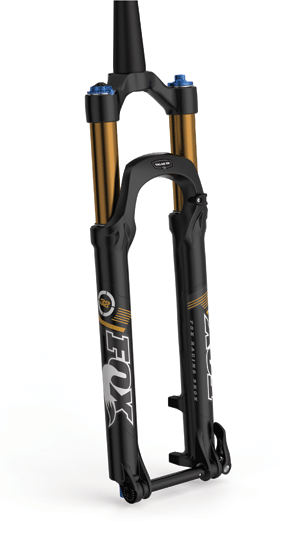
|
travel |
TALAS 2-position travel adjust system (120-95 mm) |
||
|
model features, adjustments |
|
|||
| lower leg options |
|
|||
|
spring |
air |
|||
|
riding style |
trail, XC |
Be sure your fork is properly installed before proceeding. If your fork came pre-installed on your bicycle, continue to the next section.
NOTE: Do not use any solvents or de-greasers, as these products can cause serious damage to paint and anodized parts (upper tubes, knobs, steerers).
Do not spray water directly on the seal/upper tube junction. Do not use a high pressure washer on your fork.
You can also view a Flash video on Setting Sag.
To get the best performance from your fork, it is necessary to set and adjust sag. Generally, sag should be set to 15–25% of total fork travel.
TIP: Hold the TALAS lever steady with one hand while unscrewing the aircap with the other.
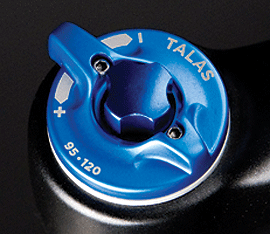
NOTE: For the best TALAS performance, always set sag in the long travel position. Sag and spring rate will automatically readjust when you change to different travel settings.
Rider | Suggested Air Spring Pressure Settings PSI |
120 mm | |
≤125 | 50 |
125 - 135 | 55 |
135 - 145 | 60 |
145 - 155 | 70 |
155 - 170 | 80 |
170 - 185 | 90 |
185 - 200 | 100 |
200 - 215 | 110 |
215 - 230 | 120 |
230 - ≥250 | 125 |
Travel | XC/Race FIRM | All-Mountain PLUSH |
120 mm (4.70") | 18 mm (0.69") | 30 mm (1.19") |
Symptom | Remedy |
Too much sag | (+) air pressure in 5 psi increments |
Too little sag | (-) air pressure in 5 psi increments |
Excessive bottoming | (+) air pressure in 5 psi increments |
Harsh ride; full travel not utilized | (-) air pressure in 5 psi increments |

The rebound adjuster knob is located at the bottom of the right fork leg. This knob has 18 clicks of potential adjustment range.
Rebound controls the rate of speed at which the fork extends after compressing. Turning the knob clockwise slows down rebound; turning the knob counter-clockwise speeds up rebound. As a starting point, turn the rebound adjuster knob all the way clockwise (full in) until it stops, then turn counter-clockwise (out) 12 clicks.
|
Knob Setting |
Setting Description |
Tuning Tips |
Setup Tips |
|
|
Slow Rebound |
Too slow and your fork will pack down and ride harsh. |
If you increase your spring rate or air pressure, you will need to slow down your rebound |
|
12 (Factory setting) |
Average Rebound |
|
|
|
|
Fast Rebound |
Too fast and you will experience poor traction and wheel hop. |
If you decrease your spring rate or air pressure, you will need to speed up your rebound setting. |
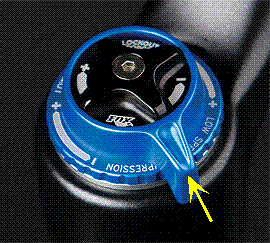
The blue compression lockout lever, located just below the black lockout force adjuster knob, allows you to close the compression damping circuit in the fork. This keeps the fork at the top of its travel, making it harder to compress.
NOTE: When you adjust the compression lockout lever, the black lockout force adjuster knob will also move. This is normal; the lockout force adjustment setting will not be affected.
Rotate the lever fully clockwise to lockout the fork. This position is useful in climbing and sprinting situations, but will sag with the rider’s weight. The fork will "blowoff" in the event that a big hit is encountered with the fork locked out.
To unlock the fork, simply rotate the lever fully counter-clockwise.
NOTE: The fork may cycle a couple of times after enabling lockout. Once complete lockout is achieved, the fork may continue to move 3 - 5 mm. This is normal and does not affect performance.
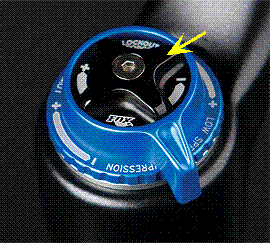
Even when your fork is fully locked out, there are instances when you still want your fork suspension to be active. To protect your fork's internal parts, your FOX fork will "blowoff" when it encounters an intense hit. You can adjust when the fork blows off—lockout force—by adjusting the black knob on the right-side top cap.
A convenient tuning feature of the lockout force knob is that it allows you to leave your fork in the locked out position—no more fiddling with fork controls when the trail requires your undivided attention. Although you might need to adjust the knob a few times to find the sweet spot, once it is found you can simply leave your fork locked out. Your fork will then respond to hits in the trail for example, but will be locked out when you are out of your saddle on a climb.
Turn the knob clockwise to increase lockout force and counter-clockwise to decrease lockout force.
NOTE: When you adjust the black lockout force adjuster knob, hold the blue compression lockout lever in place.
There are 10 clicks of adjustment. As a starting point, turn the knob all the way clockwise until it stops, then back off one click counter-clockwise.
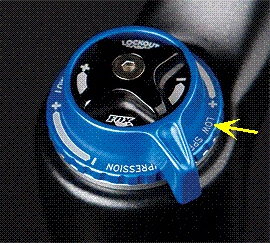
Low-speed compression damping is adjusted with the blue bezel ring that is positioned just below the blue lockout lever. This ring has 8 clicks of adjustment range. Compression damping controls the fork compression speed. Adjust the low-speed compression with lockout off (the lockout lever turned fully counter-clockwise). The factory setting is 8 clicks out counter-clockwise, from fully in clockwise.
|
Knob Setting |
Setting Description |
Tuning Tips |
Setup Tips |
|
|
Firm Compression |
Too firm and you will experience poor traction and wheel hop. |
Resists brake dive and keeps the fork up in the travel. Too firm and you may have poor traction in loose conditions. |
|
8 |
|
|
|
|
|
Soft Compression |
Too soft and your fork will pack down and ride harsh. |
Maximum wheel traction and bump compliance. Too soft and you may have excessive brake dive and a wallowy feel. |
|
|
120 mm:
|
The TALAS 29 RLC fork features two externally adjustable travel choices. These travel settings are easily selected with the TALAS travel adjusting topcap located on top of the left fork leg. Travel options and direction settings are printed directly on the topcap.
NOTE: When changing travel, the TALAS system automatically adjusts to provide you with the appropriate linear air spring rate for each travel setting. There is no need to change the air pressure in the TALAS air chamber after adjusting travel.
CAUTION: For safety reasons, adjust TALAS travel only when you're not riding the bike.
The Terralogic® damper contains a weighted brass inertia valve called Brassmass™, which freely slides on a shaft to open and close compression flow ports in the damper.
The Brassmass™ assembly automatically responds to the impact of bumps or potholes in the trail, opening the compression flow ports and allowing the flow of damping oil. The Brassmass™ assembly does not respond to rider input (pedaling, sprinting, G-outs), keeping the compression flow ports closed and maintaining the pedaling platform or the feeling of fork lockout. With the patented timer circuit constantly in control as you ride, the transition between maximum pedaling efficiency and low speed damping control is nearly instantaneous.
The 15-position blue Terralogic® threshold adjust knob located on the bottom of the right fork leg allows you to fine-tune your pedaling platform balance anywhere between lockout-firm to fully open plush damping (or zero pedaling platform).
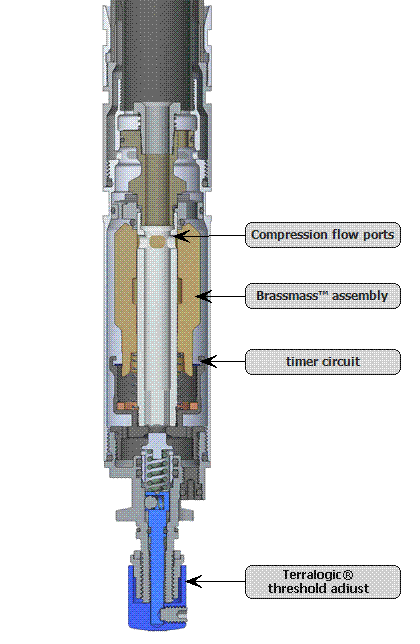
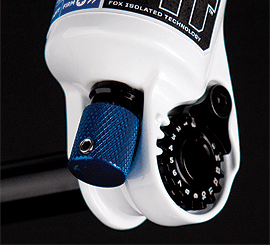
Terralogic® threshold is an adjustable compression blow-off valve that bypasses the Brassmass™ assembly, adjusted with the blue knob located on the bottom of the right fork leg. This knob enables you to regulate compression platform when the Brassmass™ assembly is closed.
NOTE: If you have just set your rebound, return the blue Terralogic® threshold adjust knob to fully clockwise in, before making your Terralogic® threshold adjustment.
To make pushing through the fork travel harder and increase the pedaling platform, turn the threshold adjust knob clockwise. Turning the adjust knob completely clockwise makes the fork feel locked out—until the Brassmass™ activates from the force of impacting a bump in the trail terrain.
To make pushing through the fork travel easier and decrease the pedaling platform, turn the threshold adjust knob counter-clockwise. Turning the knob fully counter-clockwise bypasses the effect of the Brassmass™ assembly entirely. The threshold adjust knob has fifteen (15) clicks of adjustment.
|
Knob Setting |
Setting Description |
Suggested Application |
Setting Characteristics |
|
0-4 |
Very firm pedaling platform |
XC racing and trail riding |
Offers the greatest pedaling efficiency, while sacrificing some low-speed traction. |
|
4-7 |
Moderately firm pedaling platform |
XC racing and trail riding; all-mountain |
Offers less pedaling efficiency while increasing low-speed traction. |
|
6-12 |
Light pedaling platform | Trail riding, all-mountain | Further increasing of low-speed traction, while still providing a light pedaling platform. |
|
15
|
No pedaling platform |
Downhill shuttle runs |
Offers maximum low-speed traction, without any pedaling platform. |
In the table below, FOX offers a suggested range of Terralogic® threshold adjustment settings per fork travel, as a starting point for your experimentation. As no two riders are the same (weight, strength, riding style, terrain choices, or simply that personal preference with riding "feel"), FOX encourages you to spend some time exploring the possibilities with Terralogic® threshold adjustment, to discover that "sweet spot" when it just feels right to you.
|
Fork Travel |
Suggested Terralogic® Threshold Settings |
| 3.15–3.94/80–100 | 0-4 |
| 4.72–5.12/120–130 | 4-8 |
| 5.51–5.90/140–150 | 8-12 |
Bushing Technology & Inspection | Control Direction | Oil Volumes | Structural Inspection | Dropout Thickness Inspection | Torque Values | Unit Conversion | Suspension Tuning Tips | Using the Pump | Important Safety Information | Service Intervals | Contact FOX Service | Warranty Information | FOXHelp Service Web Site
Copyright © 2011
FOX Factory Inc.